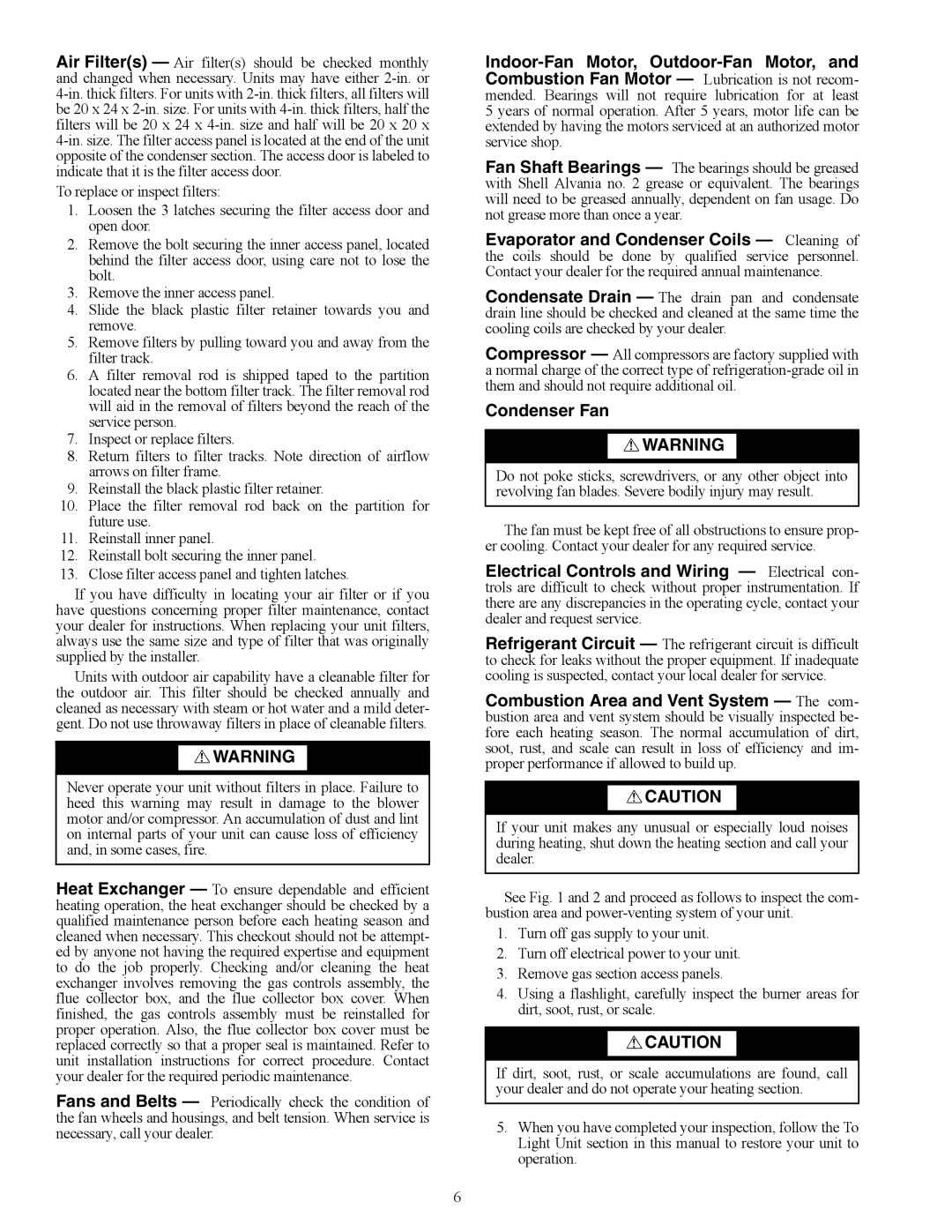
Air Filter(s) — Air filter(s) should be checked monthly and changed when necessary. Units may have either
To replace or inspect filters:
1.Loosen the 3 latches securing the filter access door and open door.
2.Remove the bolt securing the inner access panel, located behind the filter access door, using care not to lose the bolt.
3.Remove the inner access panel.
4.Slide the black plastic filter retainer towards you and remove.
5.Remove filters by pulling toward you and away from the filter track.
6.A filter removal rod is shipped taped to the partition located near the bottom filter track. The filter removal rod will aid in the removal of filters beyond the reach of the service person.
7.Inspect or replace filters.
8.Return filters to filter tracks. Note direction of airflow arrows on filter frame.
9.Reinstall the black plastic filter retainer.
10.Place the filter removal rod back on the partition for future use.
11.Reinstall inner panel.
12.Reinstall bolt securing the inner panel.
13.Close filter access panel and tighten latches.
If you have difficulty in locating your air filter or if you have questions concerning proper filter maintenance, contact your dealer for instructions. When replacing your unit filters, always use the same size and type of filter that was originally supplied by the installer.
Units with outdoor air capability have a cleanable filter for the outdoor air. This filter should be checked annually and cleaned as necessary with steam or hot water and a mild deter- gent. Do not use throwaway filters in place of cleanable filters.
![]() WARNING
WARNING
Never operate your unit without filters in place. Failure to heed this warning may result in damage to the blower motor and/or compressor. An accumulation of dust and lint on internal parts of your unit can cause loss of efficiency and, in some cases, fire.
Heat Exchanger — To ensure dependable and efficient heating operation, the heat exchanger should be checked by a qualified maintenance person before each heating season and cleaned when necessary. This checkout should not be attempt- ed by anyone not having the required expertise and equipment to do the job properly. Checking and/or cleaning the heat exchanger involves removing the gas controls assembly, the flue collector box, and the flue collector box cover. When finished, the gas controls assembly must be reinstalled for proper operation. Also, the flue collector box cover must be replaced correctly so that a proper seal is maintained. Refer to unit installation instructions for correct procedure. Contact your dealer for the required periodic maintenance.
Fans and Belts — Periodically check the condition of the fan wheels and housings, and belt tension. When service is necessary, call your dealer.
Fan Shaft Bearings — The bearings should be greased with Shell Alvania no. 2 grease or equivalent. The bearings will need to be greased annually, dependent on fan usage. Do not grease more than once a year.
Evaporator and Condenser Coils — Cleaning of the coils should be done by qualified service personnel. Contact your dealer for the required annual maintenance.
Condensate Drain — The drain pan and condensate drain line should be checked and cleaned at the same time the cooling coils are checked by your dealer.
Compressor — All compressors are factory supplied with a normal charge of the correct type of
Condenser Fan
![]() WARNING
WARNING
Do not poke sticks, screwdrivers, or any other object into revolving fan blades. Severe bodily injury may result.
The fan must be kept free of all obstructions to ensure prop- er cooling. Contact your dealer for any required service.
Electrical Controls and Wiring — Electrical con- trols are difficult to check without proper instrumentation. If there are any discrepancies in the operating cycle, contact your dealer and request service.
Refrigerant Circuit — The refrigerant circuit is difficult to check for leaks without the proper equipment. If inadequate cooling is suspected, contact your local dealer for service.
Combustion Area and Vent System — The com- bustion area and vent system should be visually inspected be- fore each heating season. The normal accumulation of dirt, soot, rust, and scale can result in loss of efficiency and im- proper performance if allowed to build up.
![]() CAUTION
CAUTION
If your unit makes any unusual or especially loud noises during heating, shut down the heating section and call your dealer.
See Fig. 1 and 2 and proceed as follows to inspect the com- bustion area and
1.Turn off gas supply to your unit.
2.Turn off electrical power to your unit.
3.Remove gas section access panels.
4.Using a flashlight, carefully inspect the burner areas for dirt, soot, rust, or scale.
![]() CAUTION
CAUTION
If dirt, soot, rust, or scale accumulations are found, call your dealer and do not operate your heating section.
5.When you have completed your inspection, follow the To Light Unit section in this manual to restore your unit to operation.
6
